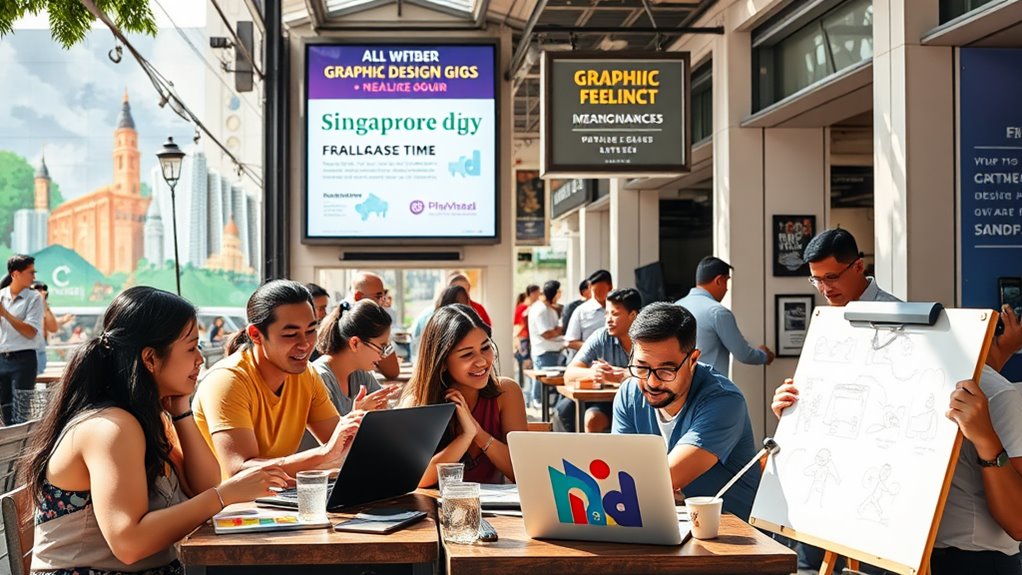To succeed as a freelance graphic designer in Singapore, you need to sharpen your skills, build a standout portfolio, and understand the market landscape. You'll find that mastering design software and creating a diverse body of work are just the beginning. While platforms like Upwork and Fiverr can connect you with clients, understanding the legal and tax obligations of freelancing is vital. What's more, networking and continuous learning can set you apart in a competitive field. So, how do you navigate these fundamental steps to establish your freelance career effectively?
Understanding Freelancing in Singapore
Freelancing in Singapore offers a unique opportunity for self-employment, allowing you to provide services directly to clients without the need for employees.
With over 50% of the self-employed population identified as freelancers, you'll be joining a vibrant community that thrives on creativity and independence. Imagine curating your schedule, working from a cozy café, or even your living room—freedom like that's exhilarating!
As a freelancer, you'll need to understand the local landscape. Citizens and permanent residents can easily engage with freelancing, while foreign freelancers must secure appropriate work permits like the Employment Pass or S-Pass.
Don't worry about obtaining licenses for most freelance services, such as graphic design or writing; however, specific trades might require supplementary steps.
You'll find plenty of platforms to connect with clients, ranging from international giants like UpWork to local job boards. Networking through social media can also open doors to exciting opportunities.
Just remember, while you enjoy this newfound autonomy, your freelance income is taxable—so keep an eye on those rates!
Welcome this experience; it's a chance to release your creativity and carve your own path in the dynamic Singaporean market.
Legal Requirements for Freelancers
Before diving into freelancing, you need to understand the legal requirements that apply to your situation in Singapore. Whether you're a local or a foreigner, compliance is key to your success and freedom.
Here are some crucial points to keep in mind:
- Citizenship Matters: Freelancers must be Singaporean citizens or permanent residents; foreigners need specific permits.
- Work Passes: If you're a foreigner, make sure you secure an Employment Pass, S-Pass, or Work Permit.
- Entrepass Option: Consider applying for an Entrepass or starting a local company with a resident director.
- No DP Work: If you hold a Dependant Pass or Long Term Visit Pass, you can't work without the proper permits.
- Industry Licenses: Most freelance services don't require a general license, but verify if your field has specific licensing needs.
Understanding these legalities allows you to release your creativity without fear, knowing you're on the right side of the law.
Accept the path of freelancing while making sure you respect Singapore's regulations. With the right knowledge, you'll not only thrive but also savor the freedom that comes with being your own boss.
Tax Obligations for Freelancers

Steering the world of freelancing in Singapore also means understanding your tax obligations. As a freelancer, your income is taxable, and knowing the right rates is essential for your financial freedom.
If you're a tax resident, living here for 183 days or more, you'll face progressive tax rates ranging from 2% to 22%. Non-residents, on the other hand, deal with a flat withholding tax of 15% on gross income or 22% on net income for professional services.
You must report your earnings to the Inland Revenue Authority of Singapore (IRAS) and file an annual tax return, usually by April 15th, covering the previous year's income.
Tax residents can enjoy personal reliefs and deductions, which can greatly lower your taxable income and total tax burden.
To navigate this labyrinth smoothly, keep meticulous financial records and receipts. These won't only substantiate your income and expenses but also make tax reporting a breeze.
Welcome the process, and you'll find that understanding your tax obligations is just another step toward liberating your freelance experience in this vibrant city!
Building Your Portfolio
A strong portfolio is vital for any graphic designer looking to attract clients and showcase their skills. To create a compelling portfolio, gather high-quality work samples that reflect your diverse graphic design abilities.
Include both personal projects and client work to highlight your versatility, and consider volunteering for local organizations to add meaningful experiences.
Here are some important elements to include:
- Diverse Samples: Show a variety of styles and techniques, from branding to web design.
- Detailed Descriptions: Provide context for each piece, explaining your thought process and the challenges faced.
- Online Presence: Utilize platforms like Behance or Dribbble to reach potential clients and industry peers.
- Professional Website: Create a visually engaging site that's easy to navigate, showcasing your portfolio alongside services and contact information.
- Regular Updates: Keep your portfolio fresh by adding new projects and removing outdated work.
Finding Clients and Opportunities

Finding clients and opportunities as a freelance graphic designer can be both exciting and challenging. To kickstart your expedition, tap into popular freelance platforms like Upwork and Fiverr. These sites are gold mines of job listings tailored just for graphic designers, connecting you with clients worldwide.
Don't underestimate the power of networking; immerse yourself in local design communities, attend industry events, and join professional social media groups. Building relationships can lead to invaluable client referrals.
A visually appealing personal website is your best friend. Showcase your portfolio, highlight your services, and make sure your contact information's easy to find. This online presence can attract potential clients who resonate with your unique style.
Consider volunteering for non-profit organizations or local businesses. This not only enhances your experience but also enriches your portfolio, paving the way for future paid gigs.
Lastly, keep an eye on local job boards and forums like Carousell and Gumtree. Many freelancers post opportunities there, making it an excellent resource for finding work right in Singapore.
With persistence and passion, you'll navigate this vibrant landscape and find the clients who inspire your creativity!
Managing Your Freelance Business
Once you've secured clients and opportunities, managing your freelance business becomes the next priority.
You've taken the initial steps toward freedom, but maintaining it requires some savvy organization and diligence.
Here's how to streamline your operations and keep that entrepreneurial spirit alive:
- Set up a separate business bank account to keep your finances clear and organized.
- Utilize accounting software for invoicing and tracking expenses, ensuring you're compliant with Singapore's tax obligations.
- Draft detailed client contracts that outline project scopes, deadlines, and payment terms to safeguard your interests.
- Implement project management tools like Trello or Asana to manage tasks and maintain clear communication with clients.
- Seek client feedback post-project to improve your services and nurture lasting relationships.
Strategies for Career Growth

As you navigate your freelance graphic design career, focusing on strategies for growth becomes vital for long-term success. To thrive in Singapore's dynamic market, continuously improve your design skills through online courses and workshops, especially in areas like UI/UX. A varied portfolio is your secret weapon; showcase different projects to attract clients and secure opportunities.
| Strategy | Impact |
|---|---|
| Specialize in niches | Differentiates you, increases demand |
| Network actively | Referrals bring new clients |
| Stay updated | Keeps you competitive, adaptable |
Leverage networking through professional groups and social media; personal connections matter in this competitive landscape. Staying updated with industry trends and advancements guarantees you maintain an edge, effortlessly adapting to clients' evolving needs. Consider specializing in niche markets like branding or digital marketing, carving out a space that resonates with your passion and expertise.
Frequently Asked Questions
How Much Do Freelance Graphic Designers Make in Singapore?
Freelance graphic designers in Singapore typically earn between SGD 30 to SGD 150 per hour, depending on experience and project complexity. With a strong portfolio, you can negotiate better rates and attract higher-paying clients.
How Can I Start Freelancing in Graphic Designing?
Freelancing freedom starts with showcasing stellar skills. Build a bold portfolio, seek small gigs, and network within the niche. Stay savvy about regulations and continually sharpen your skills to soar in this vibrant industry.
How to Become a Graphic Designer in Singapore?
To become a graphic designer in Singapore, you'll need to hone your skills through education or self-study, master design software, and build a diverse portfolio that showcases your creativity and versatility in the industry.
Does a Freelancer Need a Business License in Singapore?
You're ready to break free, but do you need a business license? Generally, no. Still, check if your specific services require licensing, and don't forget your tax obligations. Freedom comes with responsibility!
Conclusion
Starting your freelance graphic design adventure in Singapore is like stepping onto a vibrant canvas filled with endless possibilities. By mastering your craft, understanding legalities, and actively seeking clients, you'll paint a successful picture of your own. Remember, every great designer started somewhere—just like the legendary artists of yore, your unique style and vision will set you apart. So, welcome the experience, keep learning, and watch your creative dreams come to life in this bustling marketplace.
